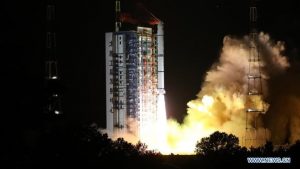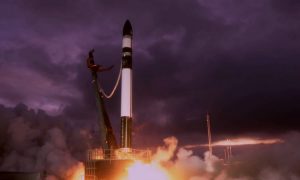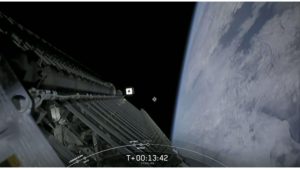Media
Transcript
First up, on June 10 at 6:31 pm UTC, a Long March 2C rocket launched the Haiyang 1D oceanography satellite from the Taiyuan space center in northern China’s Shanxi province.

The Haiyang 1D satellite was launched from the Taiyuan Space Center aboard a Long March 2C in what was the first launch from Taiyuan since the middle of January. The US military confirms the rocket placed the payload into a 775 km / 480 mi altitude sun-synchronous orbit (SSO), and Chinese officials declared the launch a success.
The 442 kg satellite was built by CAST, a subsidiary of CASC, and joins Haiyang 1C in observing ocean surface temperatures as well as ocean colors which can provide clues to near-surface chemistry and marine life. “Haiyang” is Mandarin for “ocean,” and 1D is the sixth satellite in the series.
The satellite also includes an automatic identification system for tracking of ocean-going craft, and its visual imaging systems will support coastal and ocean resource management and disaster management planning.
The rocket featured modified fairing halves built by CALT, another subsidiary of CASC. These consisted of an added “X-shaped” support structure to prevent deformation and flexing during reentry. An optical sensor was added to provide data on the conditions experienced during descent.
These modifications follow on to the addition of grid fins seen attached to the first stage in last July’s launch of a Long March 2C, intended to steer the spent vehicle away from populated areas. There were no fins on this rocket’s first stage, according to images of it during launch operations.
You may wonder, as I did, how did they get six satellites out of “Haiyang 1C” and “Haiyang 1D”; surely this is the fourth satellite? Turns out the Haiyang 1 series contains one set of instruments, the observations of which augment those of the Haiyang 2 series. Series 1 focuses more on the optical wavelengths and near-infrared (NIR); Series 2 has various radars which detect ocean surface topography and wind speeds/directions, as well as longer wavelength infrared (IR) instruments to detect ocean temps. Haiyang 2B is part of this series and is currently operational.
Next up, at 5:12 am UTC on June 13, an Electron rocket launched the “Don’t Stop Me Now” mission from Rocket Lab’s spaceport on the Mahia Peninsula in New Zealand.
Don’t Stop Me Now’s payloads were ANDESITE, NRO, and M2 Pathfinder satellites.

ANDESITE — which stands for Ad-Hoc Network Demonstration for Extended Satellite-Based Inquiry and Other Team Endeavors (whew!) — was created by electrical and mechanical engineering students and professors at Boston University.
Its purpose, according to Rocket Lab’s press release, is to study Earth’s magnetic field with onboard sensors and later release smaller satellites with more sensors “to track electric currents flowing in and out of the atmosphere, a phenomenon also known as space weather.”
The 3 National Reconnaissance Office (NRO) satellites were all designed, built, and operated by the NRO. We don’t really have any other info because, well, it’s the NRO.
The M2 Pathfinder is a demonstration satellite and collaboration between the University of New South Wales (UNSW), Canberra Space, and the Australian Government. Its purpose is to test the “ability of an onboard software-based radio to operate and reconfigure while in orbit.”
The “Don’t Stop Me Now” mission was named in memory and recognition of Rocket Lab board member Scott Smith, who was also a big Queen fan.
A few hours later and halfway across the world, SpaceX launched a Falcon 9 at 9:21 am UTC with an additional 58 satellites for the growing Starlink constellation.

According to PlanetLab’s statement on the launch, the 3 SkySats will provide high-resolution imaging available “to a variety of governmental, commercial, academic, and non-profit organizations.” They’ll join a constellation of 15 other SkySats.
Usually, Starlink satellites are launched in batches of 60, but because of the rideshare agreement, there were only 58 Starlinks to make room for the 3 SkySats. This is the first rideshare of a Starlink launch, and there are more planned.
The Starlink constellation now has 535 satellites with 418 launched this year.
To wrap things up, here’s a running tally of a few spaceflight statistics for the current year:
Toilets currently in space: 4
Toilets burned up: 2
Total satellites humans put into orbit: 541 (includes those launched from other in-orbit craft, such as the ISS)
Total satellites from launches: 525
Total 2020 launch attempts: 43 (including 5 failures)
I keep track of orbital launches by where they launched from. Here’s that breakdown:

USA: 15
China: 13
Kazakhstan: 4
Russia: 3
French Guiana: 2
Iran: 2
Japan: 2
New Zealand: 2
Your useless space fact for the week is that astronauts left poop on the moon so they could make room to bring back more lunar samples.
Learn More
China launches Haiyang-1D ocean observation satellite
University-built CubeSat launched with swarm of auroral science nodes
SkySats 16-18 Successfully Launch Aboard The SpaceX Falcon 9
Credits
Host: Annie Wilson
Writers: Annie Wilson, Dave Ballard, Ally Pelphrey
Audio and Video Editing: Ally Pelphrey
Content Editing by Beth Johnson
Executive Producer: Pamela Gay
Intro and Outro music by Kevin MacLeod, https://incompetech.com/music/


 We record most shows live, on Twitch. Follow us today to get alerts when we go live.
We record most shows live, on Twitch. Follow us today to get alerts when we go live.